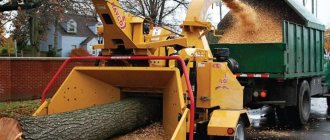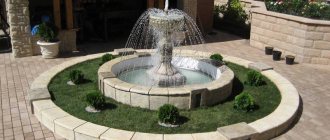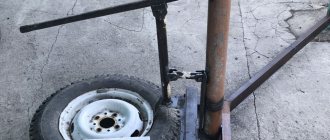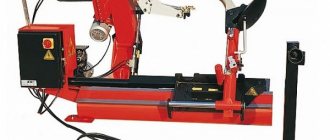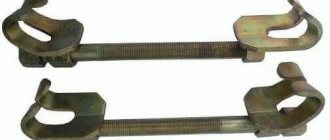Miter box
is a tool device in the form of a U-shaped tray with side slots for a saw, designed for sawing slatted material at a given angle.
When installing floor or ceiling plinths, door frames, laying electrical wiring in cable ducts or manufacturing furniture, it becomes necessary to saw the material into pieces of a given length at a right angle or a 45 degree angle. You can, of course, cut the material along the line drawn using a square. But in this case, the work requires care and it is easy to make an irreparable mistake.
To increase the productivity and quality of sawing, a simple device called a miter box was invented. The photo shows an industrial plastic miter box, with which a hand saw can be used to cut slats, bars, corners made of wood, chipboard, MDF, plasterboard, plastic and other soft materials at an angle of 45° and 90° with sufficient accuracy.
It is enough to mark one point on the rail that needs to be adjusted to size, insert the rail into the miter box so that the mark is on the line of the guides, and use a hand saw inserted with a blade into the slots to cut the rail. The miter box will not allow the saw blade to move to the side and the end of the rail will be the required one.
Industrially produced plastic miter boxes have a significant drawback: due to the larger width of the guide slots and their rapid wear by saw teeth, the accuracy of the angle is low and gaps up to one millimeter wide often remain at the junction of the baseboards or platbands. There are high-precision miter boxes on sale, which even provide the ability to change the angle within any limits, and there are clamps for fixing the material being cut. But they are very expensive, and for one-time repairs in an apartment it does not make sense to purchase such a device. Moreover, a high-precision miter box can be made with your own hands in a couple of hours from scrap material.
To make a homemade miter box, you will only need a couple of metal, preferably aluminum, plates 1.5-2 mm thick and a board for the base of the miter box about 10 cm wide made of wood, chipboard or plywood.
Step-by-step instructions: how to make a miter box
Finishing an apartment is not complete without installing skirting boards and door frames. For an aesthetic appearance, the joints are sawn at an angle of 45. Doing this yourself without a special device is problematic, especially if the material has a relief profile.
A miter box is an auxiliary device for cutting boards at the correct angle. It looks like a tray with a U-shaped profile and side cuts at the required angles. The knife blade or saw blade will move along them. You can buy a miter box at a hardware store or make it yourself, saving your budget.
Modern models are made from durable materials: plastic, hard chipboard, wood, metal. Advanced - equipped with rollers to prevent the cloth from moving, this allows you to reduce errors to a minimum.
To make a miter box, you need to select a hardwood: ash, oak, pine needles. In addition to the material, you need to prepare a tool for the job. First we decide on a hacksaw. It should have a thin blade with fine teeth.
Then we select the rest of the tool:
- Ruler, pencil, protractor;
- Screwdriver, self-tapping screws;
- Vise;
- Sandpaper.
Next we move on to cutting out the side and base. Typically, the width of the structure is 150 mm, length 250 mm, and the height of the sides reaches 50 mm. Then they move on to marking the cuts.
Algorithm of actions:
- 2 sidewalls are applied to each other;
- Align the edges;
- Fix with a vice;
- Mark the middle;
- Set aside an angle of 45 degrees and make markings so that you get a cross;
- 90 degrees are measured on the sides and marked with a line;
- Use a hacksaw to cut through 5 mm and replace it with a carpentry saw;
- Continue cutting to the base of the miter box, do not cut deeper;
- Do the same at 90 degrees;
- Use sandpaper to clean the inside of the cuts;
- The parts are released from the vice.
Next you need to assemble the box. The sidewalls are placed on glue and secured with self-tapping screws. If it is necessary to make a dismountable device, then glue is not used.
Manufacturing
The problem can be solved quite simply by making this tool yourself, spending a minimum of time, effort and materials. Also an undoubted advantage is that you yourself can determine the length of the miter box, which is important when making long elements, such as baseboards or platbands.
Note!
The design of the miter box provides for the presence of guide slots in a wooden or plastic tray. In some cases, a straight groove can be made for sawing boards. A more complex mechanical version of the miter box is equipped with built-in stops and clamps. In addition, the kit includes axle and bow saws.
Correct work with a miter box
You don't just need to make a miter box. To cut a skirting board well, you need to know how to handle it. Before performing the main work, it is better to practice on scraps of wood or leftover foam.
Angles are divided into external and internal, and joints have a right and left side. The right plinth is placed in the miter box on the right side, the corner is made on the left. The left one is placed on the left side, the corner is sawed off on the right.
There are 4 main mistakes made by beginners:
- Incorrect measurement.
- Confusion with internal and external angles.
- Lack of knowledge of the features of sawing ceiling and floor skirting boards. The technology is different.
- Lack of matching angles after cutting.
To make the inner corner of the floor plinth, the miter box is placed on the tabletop, and the plinth is pressed against the far side. The right part is placed on the right and brought to the diagonal, the cut is made from right to left. The part that is placed on the left side is cut from left to right. To cut the part evenly, the cut is made with smooth movements. The pressure is directed towards the thrust wall. The skirting boards are joined together. The angles must match, the top is directed in the opposite direction from the observer.
Usage
Having a ready-made miter box, you can begin manufacturing and cutting parts. But it is worth mastering a few rules for its proper use:
- Correctly determine the angles. It is necessary to take into account that the plinth has a left and a right side. Therefore, if we nail the baseboard on the right side of the room, then we cut it on the left and vice versa.
- Do not confuse internal and external corners. To do this, it is worth making preliminary markings of the material, and then matching these marks with the grooves on the miter box. For reliability, the structure must be secured with clamps and only then sawed.
- Remember that ceiling and floor skirting boards are opposite to each other, so cutting them should be done in the reverse order.
- If you lack experience, it is advisable to fix the cut plinth in the same position in which it will be located on the floor or ceiling.
- It will always be a good idea to fill your hand first - to practice on scraps.
Making a miter box with your own hands is not at all difficult. Such a carpentry tool will always be useful to you for cutting ceiling and floor plinths, cutting out various lugs and frames, creating coziness in the house and beauty in the garden.
External and internal corners
The technology for sawing off the internal ceiling plinth is similar to the floor plinth. The difference is in the location of the fillet in the miter box.
Work rules:
- The miter box is placed on the table;
- The plinth is pressed against the near side;
- The right element is placed on the right side, the cut goes from left to right;
- Left - on the left side, sawing from right to left.
The angle must be joined - the vertex is directed away from the observer. For convenience, you can draw drawings to speed up the work. Next, the plinth is fixed to the ceiling. The corner should be smooth. The fillets can be glued to the ceiling surface or wall.
The outer one is made in a similar way, but the plinth is placed on the far side of the miter box. The right one is cut from right to left, but the left one is cut from left to right.
Sometimes it is not possible to remove the fillets accurately, and small gaps remain. Cover the corner joint with gypsum putty, mixed with water-based paint. You can install decorative corners.
If you have a good eye, use a paper template. To do this, on a thick sheet of paper you need to draw a model of the miter box in the form of a rectangle, and mark the corners. Next, draw bold lines. The plinth is trimmed as in a miter box. In this case, it is not inserted, but placed on the template, the lines are aligned, and the cut is made in accordance with the markings.
Adhesive compositions
Glue for suspended ceilings on which foam fillets are attached should not contain aggressive chemicals based on benzene, acetone, etc. Upon contact with polystyrene foam, the latter will enter into a chemical reaction and lose its user properties.
It is recommended to use glue for the following types of foam ceiling skirting boards:
- Direct use in the form of a dry mixture. Preparation for use is detailed on the powder packaging. When purchasing, you should carefully consider the expiration dates and storage conditions of the composition. The price of such glue is budget, the consumption is small. Fastening to metal surfaces and concrete is not recommended.
- On a polyurethane basis. The advantages of the compositions include a convenient method of application to the surface, excellent adhesion during distribution, moisture resistance and low design consumption. The cost depends on the brand. When making this choice, you should pay attention to the components that make up the glue. If solvents are detected, it should not be used on polystyrene foam.
- Fastening with sealants. Due to its short drying time, its use requires experience. It is not recommended for beginners to use it.
- Self-prepared mixtures. They can be combined with dry glue and “liquid nails” or a mixture of putty and PVA glue in a ratio of 1/5. Mixing of the composition is carried out immediately before installation.
READ How to wipe dry foam from hands
Attention! Adhesive compositions from dry mixtures should be made in portions - they “set” quickly, and it will not be possible to mix them again. At the same time, freshly prepared glue should sit for 5-10 minutes before use.
A simple way: how to correctly make a corner of a plinth for a ceiling
There is another way to make a corner on a ceiling decorative strip without using a miter box. To do this, markings are applied to the wall and ceiling.
Work order:
- The fillet is applied to the ceiling surface, pressing the smooth edge tightly to the corner;
- Draw lines above and below, one on the ceiling, the other on the wall under the baseboard;
- Similar actions are carried out on the opposite side;
- Dots are placed at the intersection of the upper and lower lines;
- The plinth is applied again, pressing it into the corner, and the marks are transferred to it;
- The points are connected into one line;
- They are cutting.
Next, the fillet is checked for alignment. If the walls are not level, make an allowance of 1 cm. In case of errors in measurement, the corners are joined first. Additional insertions must be made on the periphery.
Even with all your efforts, the angles are not always perfect. Therefore, it is necessary to make a homemade miter box, install and fix the plinth in it. It’s better to spend time on manufacturing, so that later the work will go faster. Correctly adjusted corners look neat and aesthetically pleasing, completing the design composition.
DIY miter box: choice of wood, tools and drawings. How to properly install and use the tool.
During repairs, a variety of tools are required. Sometimes it is necessary to cut parts at an angle of 45. This can be done with high precision using a special device. A DIY miter box will help you save your budget and will be an excellent assistant in repairs.
Classification division - types of tools
A miter box is a simple tool to use. Learning how to make a miter box at home is very simple. But, despite all this ease of use and operation, the devices have their own classification scale:
- Simple is the most popular model produced by companies for domestic use. In most cases, the model does not contain additional functions or accessories with the exception of slots for cutting tools. The simplest miter box model is designed for processing materials made of plasterboard, wood, plastic, including bars, profiles, slats and baseboards.
- Rotary - differs from the simple model by the presence of a hacksaw up to 600 mm long, which is mounted on a plastic or metal base. This design can be rotated up to 135 degrees.
- Electric - practically no different from a rotary miter box. The only difference is that the saw available is electric.
A simple miter box is designed for processing drywall, wood and plastic at home.
The last two modifications belong to the category of professional tools; they allow you to cut products in two planes. When buying such a unit, you should give preference to metal and aluminum models, which have the highest performance in terms of durability, durability and reliability. If desired, you can purchase a device made of hardwood, but their cost is very high due to the expensive raw materials for the production of the tool.
Professional models can also be used at home, but their cost is too high compared to simple devices.
Such models have found their use in professional workshops where maximum accuracy, high productivity, and the ability to work at different angles are required. Unlike simple miter boxes, in rotary and electric modifications, a cutting structure with a saw blade is used together with the slots. The saw is a thick saw, which is equipped with a special pad. Thanks to the functioning of such overlays, craftsmen in workshops are able to make precise cuts of profiles, baseboards and slats at any angle as quickly and accurately as possible.
Step-by-step instructions: how to make a miter box
Finishing an apartment is not complete without installing skirting boards and door frames. For an aesthetic appearance, the joints are sawn at an angle of 45 degrees. Doing this yourself without a special device is problematic, especially if the material has a relief profile.
A miter box is an auxiliary device for cutting boards at the correct angle. It looks like a tray with a U-shaped profile and side cuts at the required angles. The knife blade or saw blade will move along them. You can buy a miter box at a hardware store or make it yourself, saving your budget.
Modern models are made from durable materials: plastic, hard chipboard, wood, metal. Advanced - equipped with rollers to prevent the cloth from moving, this allows you to reduce errors to a minimum.
To make a miter box, you need to select a hardwood: ash, oak, pine needles. In addition to the material, you need to prepare a tool for the job. First we decide on a hacksaw. It should have a thin blade with fine teeth.
Then we select the rest of the tool:
- Ruler, pencil, protractor;
- Screwdriver, self-tapping screws;
- Vise;
- Sandpaper.
Next we move on to cutting out the side and base. Typically, the width of the structure is 150 mm, length 250 mm, and the height of the sides reaches 50 mm. Then they move on to marking the cuts.
Algorithm of actions:
- 2 sidewalls are applied to each other;
- Align the edges;
- Fix with a vice;
- Mark the middle;
- Set aside 45 degrees and make markings so that you get a cross;
- 90 degrees are measured on the sides and marked with a line;
- Use a hacksaw to cut through 5 mm and replace it with a carpentry saw;
- Continue cutting to the base of the miter box, do not cut deeper;
- Do the same at 90 degrees;
- Use sandpaper to clean the inside of the cuts;
- The parts are released from the vice.
Next you need to assemble the box. The sidewalls are placed on glue and secured with self-tapping screws. If it is necessary to make a dismountable device, then glue is not used.
Subtleties of choosing a saw
Even before you start creating a miter box, you will need to choose the right hacksaw. A high-quality tool has small teeth, thin blades, high rigidity and strength . The small size of the teeth allows for accurate cutting without damaging the condition of the wood surface. The thinness of the blades guarantees greater precision of cuts - right along the intended line.
In the case of rigidity of the canvas, the required condition is achieved with the help of an additional element called a butt.
If you are going to process skirting boards or stucco molding made of polyurethane, then the hacksaw must be made of metal.
Correct work with a miter box
You don't just need to make a miter box. To cut a skirting board well, you need to know how to handle it. Before performing the main work, it is better to practice on scraps of wood or leftover foam.
Angles are divided into external and internal, and joints have a right and left side. The right plinth is placed in the miter box on the right side, the corner is made on the left. The left one is placed on the left side, then it is sawed off on the right.
There are 4 main mistakes made by beginners:
- Incorrect measurement.
- Confusion with internal and external angles.
- Lack of knowledge of the features of sawing ceiling and floor skirting boards. The technology is different.
- Lack of matching angles after cutting.
To make the inner corner of the floor plinth, the miter box is placed on the surface of the table, the bar is pressed against the far side. The right part is placed on the right and brought to the diagonal, the cut is made from right to left.
Left - placed on the left side, the cut is made from left to right. To cut the part evenly, the cut is made with smooth movements. The pressure is directed towards the thrust wall. The skirting boards are joined together. The angles must coincide, the top is directed in the opposite direction from the observer.
What it is?
This word comes from several ancient roots included in many European languages. “St” - translated means “to approve, put”, “sl” - “to fold”, the ending “o” indicates that it helps to fold and connect. As an example, you can take a few words. For example, a chisel is something that helps to chisel, a drill is something that can be used to drill.
As you can see, the very meaning of the word “miter box” encrypts its use. With its help, you can make parts that stack with each other. There is also one ancient concept: “to connect in a mustache” (without flaws) - some masters translate the name of the instrument this way. The same meaning is encrypted in the more understandable word “to hang out” - to meet, connect, get together.
A miter box is an auxiliary carpentry tool designed for sawing materials at a strictly specified angle. The correct angle, as well as a neat cut, are especially important when installing finishing materials, for example, ceiling or floor plinths, baguette frames or platbands.
This convenient device is mounted on a workbench or other surface using screws, clamps or self-tapping screws - only reliable fastening can ensure the quality of the cut made.
External and internal corners
The technology for sawing off the internal ceiling plinth is similar to the floor plinth. The difference is in the location of the fillet in the miter box.
Work rules:
- The miter box is placed on the table;
- The plinth is pressed against the near side;
- The right element is placed on the right side, the cut goes from left to right;
- Left - on the left side, sawing from right to left.
The angle must be joined - the vertex is directed away from the observer. For convenience, you can draw drawings to speed up the work. Next, the plinth is fixed to the ceiling. The fillets can be glued to the ceiling surface or wall.
The external version is made in a similar way, but the plinth is placed on the far side of the miter box. The right one is cut from right to left, the left one is cut from left to right.
Sometimes it is not possible to remove the fillets accurately, and small gaps remain. Cover the corner joint with gypsum putty, mixed with water-based paint.
If you have a good eye, use a paper template. To do this, on a thick sheet of paper you need to draw a model of the miter box in the form of a rectangle, and mark the corners. Next, draw bold lines. The plinth is trimmed as in a miter box. In this case, it is not inserted, but placed on the template, the lines are aligned, and the cut is made in accordance with the markings.
A simple way: how to make an angle correctly
There is another way to make a corner on the ceiling plinth without using a miter box. To do this, markings are applied to the wall and ceiling.
Work order:
- The fillet is applied to the ceiling surface, pressing the smooth edge tightly to the corner;
- Draw lines above and below, one on the ceiling, the other on the wall under the baseboard;
- Similar actions are carried out on the opposite side;
- Dots are placed at the intersection of the upper and lower lines;
- The plinth is applied again, pressing it into the corner, and the marks are transferred to it;
- The points are connected into one line;
- They are cutting.
Next, the fillet is checked for alignment. If the walls are not level, make an allowance of 1 cm. In case of errors in measurement, the corners are joined first. Additional insertions must be made on the periphery.
Even with all your efforts, the angles are not always perfect. Therefore, it is necessary to make a homemade miter box, install and fix the plinth in it. It’s better to spend time on manufacturing, so that later the work will go faster. Correctly adjusted corners look neat and aesthetically pleasing, completing the design composition.
